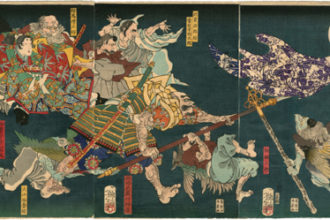
Welcome to Chapter 2: Group Patrons! You know what, I’m not even going to guess how far I’ll get in this article. I’ll just come back and write this section more clever-like when I’ve done it.
Part One | Part Two | Part Three | Part Four | Part Five | Part Six | Part Seven | Part Eight
Chapter 2: Group Patron
If you’ve read my Eberron: Rising from the Last War breakdown, you may recall that I was enthralled with the Group Patron chapter of that book. Interesting – this chapter was 38 pages in Eberron, and only 20 pages here. The chapter presents eight broad categories of patrons, several of which might overlap, or be competing interpretations of the same concept: Academy, Ancient Being, Aristocrat, Criminal Syndicate, Guild, Military Force, Religious Order, and Sovereign.
Each of those patron types gets its own descriptive section, broken down into a table of Types (that is, drilling down into six forms of academy, six different kinds of aristocrat, whatever), a list of Perks (what the patron does for you in return for all this questing), a table of six Contacts (the NPC who is the face of the organization for the PCs – you might plausibly use all of these in the course of a campaign, especially as signs of increasing status), a table of character roles (suggestions of ways your individual character fits into that organization, and backgrounds that hook up to it), and a table of six quests appropriate to that patron.
In short, it’s an incredible wealth of inspiration for each patron. To my eyes, it’s eight patrons multiplied by six types, resulting in at least 48 very grabby campaign concepts. That’s before you get into concept blends, bait-and-switch moves, or how much a setting change can spin any of these.
The only section here that is even in danger of being a weak point is the concluding Being Your Own Patron piece. It isn’t bad, it’s just… a way of saying that even campaigns not using this chapter’s model still fit within it. I think it would need to deliver a bit more to stick that landing. It doesn’t take anything away from the rest of the chapter. Out of a book I really like, this might be my favorite chapter. Forty-eight campaign concepts, people.
Back in 2020, as part of the Edition Wars podcast, Samuel Dillon and I covered the 3.5e Unearthed Arcana and the 3.5e DMG 2. Both of those explore mechanics for patron-driven stories along these lines. What this chapter doesn’t do is present antagonist factions (though you can extrapolate them from this with a moment’s thought, if it suits you). Other than that, it’s a strikingly cleaner presentation that gets right to the exciting, table-usable stuff.
To venture for a moment into what isn’t here – I wish that a few of the Perks dipped a toe into mechanical payoffs. The Ancient Being can give you Supernatural Gifts – I just wish 5e had a conceptual space for nonmagical training bennies in the vein of Supernatural Gifts. (I remember you well, 4e DMG 2!)
Chapter 3: Magical Miscellany
This chapter is a substantial portion of the book, though smaller overall than the new magic content of XGTE, I think? It’s broken into spells and magic items, much more tilted toward magic items than spells, while XGTE was the reverse.
Spells
Twenty-one new spells, to be precise, discussed here in alphabetical order.
Blade of disaster also showed up in Rime of the Frostmaiden. As I said in my review, I was delighted to see this callback to 2e’s black blade of disaster. This is spiritual weapon on steroids: it deals more damage (4d12 twice for a 9th-level slot rather than 4d8+Wis once for an 8th-level slot), it has extra-brutal crit rules (18-20/x3 crit, to borrow some 3.x parlance), and it can pass through any barrier, up to and including a wall of force. On the other hand, it requires concentration, as spiritual weapon quite notably does not. You’ve got good odds of a steady average of 52 damage per round as your bonus action, with at least some of those rounds going explosively high with your 15% crit chance.
Booming blade is one of the four melee(ish) attack cantrips that Tasha found in the Sword Coast Adventurer’s Guide and saw fit to touch up and rerelease. There’s a lot of work hidden in “touch up” in that sentence, and I’m going to try to explain it in brief here. It was a Whole Bloody Thing when Tasha released her book. I am cribbing heavily from ThinkDM’s article on this, because there are enough micro-results that it’s easy to miss some.
These four spells – booming blade, green-flame blade, lightning lure, and sword burst – previously had a range of 5 ft, or 15 ft for lightning lure. That has changed to Self (5 ft), or Self (15 ft) for lightning lure. This has major implications around the Spell Sniper feat, which previously doubled the range of these spells. Also, changing the range to Self means these spells can’t be twinned with metamagic. Booming blade and green-flame blade do still work with War Caster, per direct confirmation from Jeremy Crawford.
Booming blade and green-flame blade are also explicitly dependent on the weapon in your hand when you cast, so it matters that they now have a material component: “a melee weapon worth at least 1 sp.” That closes off combining these spells with XGTE’s 2nd-level shadow blade spell, which was a common combination for Arcane Tricksters in particular. Jeremy Crawford also explicitly confirmed that the weapon created by the Pact of the Blade does satisfy this material component.
WotC absolutely had to include these spells in this book because their policies around how many (and which) books you have to have to use content would make trouble for the artificer, which gets all four of these cantrips, as do sorcerers, warlocks, and wizards (and, by extension, Eldritch Knights and Arcane Tricksters).
These are still great spells for a lot of builds – artificers, bladelocks, EKs, ATs, probably a fair number of bards… but most of all anyone that gets to cast a cantrip and attack as part of the same action.
Dream of the blue veil at 7th level is the first official world-walking spell, taking you from one Material Plane world to another. It only works if you’ve already got a magic item or someone from the world you want to get to, not unlike attuned rods for plane shift. The thing is, if you know even one thing about the Material Plane world you want to get to and have a rod attuned to the Material Plane, I think you could use plane shift to get there from any non-Material plane? If you have the sigil sequence for a teleportation circle on that target world, you can get there with teleportation circle, because you’re on the same plane (which the Traveling to Other Worlds sidebar points out).
This spell has a 10-minute casting time, but that casting time only starts the transit – you then undergo six hours of strange visions. You’re not using this spell to get out of a dangerous situation. It’s a cool, flavorful spell that – thanks to its requirements – DMs don’t have to open the door to until and unless they want. I’ve been thinking about planar-travel utility spells a bit lately. My feeling is that they all need a slight facelift so that they collectively form an interrelated, tiered set of options.
The Traveling to Other Worlds sidebar is one of the most significant infodumps of canon around D&D’s multiversal history. It introduces the First World as a concept, and in broad strokes discusses how all worlds bear the people of the First World. Nice bit of “this matters if you want it to, otherwise nah.” I like dream of the blue veil – I don’t really like having teleport and teleportation circle cover the same utility need, even with a little more information. I get how they “have to” work that way because of they’re on the Material Plane; I would prefer for them to have been written differently in the first place.
Green-flame blade now has the option to splash damage to a second target, but it’s not obligatory. That splash damage won’t always work, but the times it does, I find this spell incredibly satisfying.
Intellect fortress is one that we saw in a UA psionics release. Here it has come down from 5th level to 3rd, and its function has changed a bit. It’s not self-only anymore, and you don’t spend a reaction to defend allies; instead it’s a buff that grants resistance to psychic damage and advantage on Int/Wis/Cha saves. I like that higher-level slots get you additional targets for the same expenditure of concentration, though any defensive buff that takes concentration feels fragile, in a sense. Anyway, great spell, and I’ve enjoyed seeing it in recent Critical Role episodes.
Lightning lure has always been a favorite of mine just for its forced movement – you’re pulling some jerk right into your opportunity attack range. The only thing I want to see added to this is an explicit statement that you can also use this on immobile objects, so you can swing across chasms or pull yourself toward things that are out of reach.
Mind sliver is the fifth attack cantrip, and one we saw in that same UA psionics release, and another one before it. I’ve liked it in each release, and I liked seeing the Scribe wizard in one of my sessions using it. It’s a psychic damage spell that is great for setting up another spell that requires a saving throw.
Spirit shroud at 3rd level is a self-only 1d8 damage buff that only works on creatures that are within 10 feet of you. This damage blocks healing until the start of your next turn. The area of the spell also slows down enemies that are within 10 feet. The damage buff scales with every two spell levels. That’s a lot of stuff going on and I am in favor of all of it – it’s especially incredible for Eldritch Knights.
Next up is a whole family of summon spells, largely intended as a more usable approach to summoner play that doesn’t lean on a large number of separate creatures. Aberration, Beast, Celestial, Construct, Elemental, Fey, Fiendish, Shadowspawn, and Undead exist as separate spells, ranging from 2nd to 6th level. I’m not going to dig into each one; what you need to know is that most of them have 1-3 internal options, which does a lot of expand the utility and interest of each spell. The spells also offer scaling with spell levels, yielding more hit points, attack bonus, attacks per round (always half the spell’s level), and AC.
Sword burst is the true AoE of the melee cantrips, much like thunderclap but leaning on Dex saves rather than Con saves, and force damage rather than thunder damage.
Tasha’s caustic brew at 1st level is a line AoE spell that deals immediate acid damage as well as acid damage over time to each creature that fails their Dex save. We don’t get that many damage-over-time spells in 5e, in part because fights aren’t expected to run more than about three rounds, but if you pick your shot well, this is worth keeping handy.
Tasha’s mind whip at 2nd level is a single-target psychic damage spell that tacks on light action denial – no reactions, and on the target’s next turn it only gains one of its movement, its action, or its bonus action. The damage is only okay, but the damage you can potentially avoid with that action denial might be significant. Cast at higher levels, it pays off with additional targets rather than additional single-target damage. An interesting damage/debuff spell.
Tasha’s otherworldly guise at 6th level is replacing the classic fiendform, allowing you to take on a fiendish or celestial aspect. It grants three immunities – either fire/poison/poisoned for the Lower Planes or radiant/necrotic/charmed for the Upper Planes – as well as a flying speed, an AC bonus, the ability to use your spellcasting stat in place of Strength or Dex for weapon attacks, and Extra Attack. You can probably guess that I’m not thrilled about the immunity, though breaking concentration to drop immunity is a gaping weakness, comparatively speaking.
And that’s all the new spells.
Personalizing Spells
Thanks in part to the growth of streamed games and actual play podcasts, I’m seeing a lot more groups put energy into descriptive narration of spells and other actions. This section is here to support that, with a few instructive paragraphs and a d10 table of spellcasting themes for inspiration. It has a lot in common with the Nimbus from Mage: the Awakening, as a signature for your magical effects. If I didn’t already have a pretty clear theme for my wizard in Colin’s game, I’d probably use or riff on one of these.
Magic Items
There are forty-seven new pieces of loot. Everyone loves loot, right?
I never go item-by-item in these breakdowns, because there’s just not enough to say about individual items. There are some wonderful trends here, though, and I want to call those out.
- Tattoos showed up in a UA release (God, I wrote that 12 days into COVID-19 lockdown, I would have believed it had been three years), and now they’re in official release. Fascinating, fun concept. I look forward to buying them at Fell’s Tattoo Parlor in Sigil.
- Cool spellcasting implements beyond the wand of the war mage – there’s the all-purpose tool (heh), the amulet of the devout, and so on. They all offer something beyond their +X to spell attacks and spell DCs, which… honestly carries a lot more interest than being simple math fixers.
- Shards from various planes – Astral, Feywild, and so on – are specifically for sorcerers. Class-specific itemization is still pretty slim in official releases overall, prior to this book.
- Moving in that direction means more hand-selected treasure (to avoid useless loot) or more magic item selling or trading (to do something useful with it), rather than random (or official-adventure-text) loot assignment. There’s a whole economy to magic items in tabletop games that (still, for whatever reason) doesn’t get a lot of attention, or at least not public discussion.
- Magic tomes (one of which is not pages between a cover) are, of course, specifically for wizards. They contain a few spells – some of them are not typically wizard spells, such as word of recall in the atlas of endless horizons, but they’re wizard spells for you while attuned to the book. You can prepare spells directly from the book, or spend a minute and a charge to trade out a prepared spell for one in the book. They also have their own unique powers.
- As someone who plays a number of wizards, these are fascinating and exciting magic items.
- A few other items, like the prosthetic limb (now without attunement required) and the cauldron of rebirth. As a lifelong fan of the Chronicles of Prydain and the Warlord Chronicles and the Chronicles of Riddick and o no everything is chronicles
- What was I saying? Right, so, as a fan of those first two things, a cauldron that brings the dead back to life is extremely my deal. It does other stuff as well, like making a potion of greater healing, but what we really need is the corrupted version that animates the dead…
- Finally, six artifacts of classic D&D lore, from the crook of Rao to the teeth of Dahlver-Nar. I think that most of these date back to 1e releases, if not earlier, and (as with all artifacts) any one of them could be the centerpiece of a major story arc or whole campaign. As you’d expect, each artifact entry is massive, covering 1-2 pages (or more, for the teeth).
- In fairness, the names of some of the non-artifact items in this chapter are grabby enough that it wouldn’t seem weird to hang multiple adventures on them, like the planecaller’s codex. I’m sure this isn’t just a transferred bias on my part from working on Candlekeep Mysteries…
In short, I love everything in the magic item section. Obviously I want more, but y’all, I bought the 2e Encyclopaedia Magica (all four volumes); I’ve conclusively proven that my appetite for interesting magic items won’t be sated in this life.
That brings us to the end of Part Eight, and as you can see, I have nothing but good to say about Chapters 2 and 3. Next time, I hope that I’ll finish up the book with Chapter 4: Dungeon Master’s Tools.



